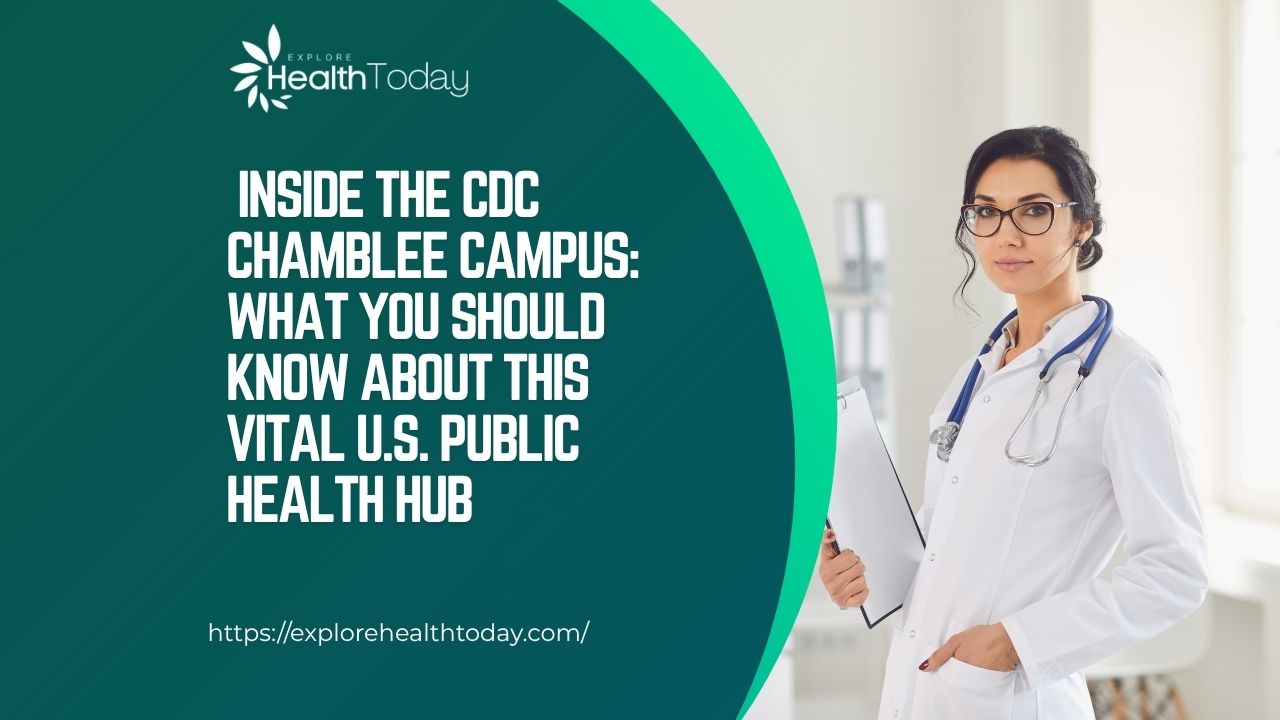When you think about disease control and prevention in the United States, your mind likely jumps to the CDC—one of the most respected public health organizations in the world. While many people are familiar with the CDC headquarters in Atlanta, Georgia, not as many know about the equally important CDC Chamblee Campus, located just northeast of downtown Atlanta.
This lesser-known but critical branch of the CDC plays a powerful role in public health research, policy development, and disease response. As public health challenges evolve in 2024 and 2025—from emerging infectious diseases to chronic illness prevention—understanding the role of facilities like the Chamblee Campus becomes more relevant than ever.
What Is the CDC Chamblee Campus?
The CDC Chamblee Campus is one of the main operational facilities of the Centers for Disease Control and Prevention (CDC). It is located in Chamblee, Georgia, a city in DeKalb County, just a few miles from CDC’s main Roybal Campus.
This campus houses multiple CDC divisions and offices, particularly those focused on environmental health, injury prevention, and occupational safety.
Quick Facts:
- Location: Buford Highway, Chamblee, GA
- Opened: Originally a U.S. Navy supply depot, converted to CDC use in the mid-20th century
- Specialties: Environmental health, toxicology, occupational health, and emergency response
- Divisions Located Here:
- National Center for Environmental Health (NCEH)
- Agency for Toxic Substances and Disease Registry (ATSDR)
- National Institute for Occupational Safety and Health (NIOSH)
- National Center for Environmental Health (NCEH)
Why the Chamblee Campus Matters in 2024–2025
While the CDC is often spotlighted during major infectious disease outbreaks like COVID-19 or influenza, the Chamblee Campus leads vital work that happens behind the scenes—especially in areas that directly impact everyday life.
Areas of Focus:
- Monitoring water and air quality
- Responding to environmental disasters
- Investigating chemical exposures
- Setting national health safety standards for workplaces
Given increasing concerns around climate change, wildfires, and industrial pollution, the work done at the Chamblee Campus has gained significant attention in recent years.
In 2024, for instance, CDC researchers from Chamblee collaborated with FEMA and the EPA to respond to toxic chemical exposures following a train derailment in the Midwest—a real example of inter-agency response rooted in the work at this campus.
What Happens at the Chamblee Campus?
National Center for Environmental Health (NCEH)
This center addresses how environmental factors like pollution, natural disasters, and toxins affect human health. Current NCEH projects include:
- Tracking asthma and respiratory illness trends tied to urban air pollution
- Studying lead exposure risks in older homes and communities
- Climate and Health Program partnerships with states to address extreme heat events and natural disasters
More info on these initiatives can be found at the CDC’s Environmental Health page.
Agency for Toxic Substances and Disease Registry (ATSDR)
Housed on the Chamblee Campus, the ATSDR responds to toxic substance exposures and evaluates health risks in affected communities. In 2025, ATSDR is expanding its community health studies to include PFAS exposure, a major national concern involving “forever chemicals” found in drinking water.
This branch is also behind many public health assessments conducted after chemical spills or industrial accidents.
NIOSH (National Institute for Occupational Safety and Health)
NIOSH at Chamblee is dedicated to worker health and safety, overseeing:
- Respiratory health for workers in mining, agriculture, and construction
- Chemical exposure limits and PPE guidance
- Research into occupational stress and mental health trends post-COVID
With labor laws evolving in 2025 to include stricter heat protections for outdoor workers, NIOSH’s guidance from the Chamblee team has played a role in shaping national policy. You can access their resources on the official NIOSH website.
Impact of the CDC Chamblee Campus on Public Health
The Chamblee Campus may not always make headlines, but its work has long-term national implications. Here’s how:
Emergency Response & Surveillance
From hurricanes to hazardous waste spills, Chamblee-based teams often deploy quickly to assist in national emergencies. For instance:
- After the Maui wildfires in 2023, Chamblee staff helped assess air quality risks and coordinated with local hospitals.
- During the 2024 Ohio chemical spill, ATSDR experts from Chamblee led water testing and exposure communication efforts.
Advancing Public Health Equity
Many of the programs run from the Chamblee Campus prioritize underserved populations. Whether it’s studying lead levels in low-income housing or examining asthma rates in urban Black communities, their data drives equity-focused public health decisions.
Collaborations with State and Local Health Departments
Chamblee researchers work with local agencies across the country to apply national insights to regional challenges. They provide technical assistance, help develop environmental tracking systems, and offer real-time exposure assessments during local crises.
Security and Infrastructure
As part of the CDC’s modernization initiative, the Chamblee Campus is undergoing upgrades to strengthen its role as a national resource:
- Updated laboratory facilities to meet Biosafety Level 3 standards
- Improved cyberinfrastructure for secure data sharing
- Expansion of workforce training facilities for field epidemiologists
These updates support the Biden administration’s 2024–2025 agenda to enhance the country’s preparedness for both natural and man-made health threats.
Can the Public Visit the CDC Chamblee Campus?
Unlike the CDC Roybal Campus, which has more security and limited access, some educational tours and collaborative events have historically been held at Chamblee (by appointment or invitation). However, as of 2025, general public tours remain limited due to ongoing security measures and modernization projects.
For updates on public access and educational programs, visit the CDC’s main contact portal.
Employment and Training at Chamblee
If you’re a public health student or professional, the Chamblee Campus offers:
- Fellowships and internships through the Public Health Associate Program (PHAP)
- Postdoctoral research opportunities in environmental health and toxicology
- Career opportunities for scientists, engineers, and policy analysts
To explore openings, visit the CDC’s Careers page.
The Future of the CDC Chamblee Campus
In a time when environmental threats and occupational safety concerns are at an all-time high, the Chamblee Campus continues to evolve. With additional funding allocated in the 2025 federal budget for public health modernization, expect expanded roles in:
- Disaster response preparedness
- Community engagement
- Advanced disease surveillance
The campus will also play a role in the CDC’s Health Equity Science Office, ensuring environmental and occupational health efforts prioritize vulnerable populations across the U.S.
Conclusion
The CDC Chamblee Campus might not always be in the spotlight, but it’s an essential piece of the nation’s public health puzzle. From environmental justice to emergency response, the work being done at Chamblee is shaping the future of how the U.S. prepares for and responds to health threats.
As we move through 2025 and beyond, public trust in science and health systems remains critical—and facilities like the Chamblee Campus are working every day to earn and reinforce that trust through research, response, and resilience.
Want to stay informed about the nation’s environmental and occupational health efforts? Follow updates from the CDC’s Environmental Health divisions and explore how the Chamblee Campus contributes to a healthier America.
About ExploreHealthToday.com
ExploreHealthToday.com was created to be a one-stop resource where readers can find up-to-date, well-researched articles on a variety of health topics. From nutrition and wellness to lifestyle and mental health, we strive to provide reliable information to help you make informed decisions about your well-being.
We believe that good health starts with good information, and our mission is to empower our readers with knowledge they can trust.
Visit us at ExploreHealthToday.com to learn more





